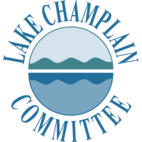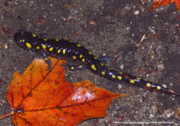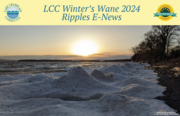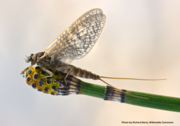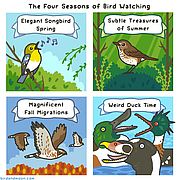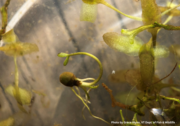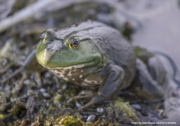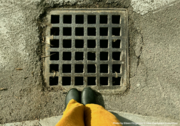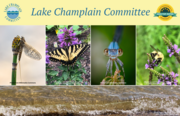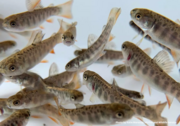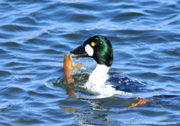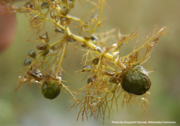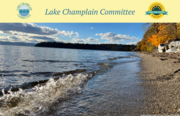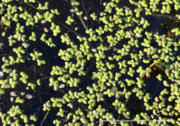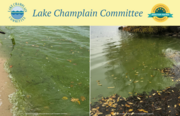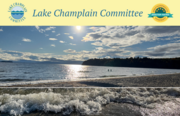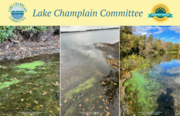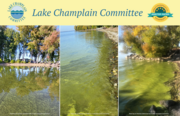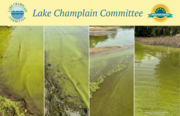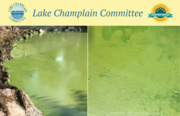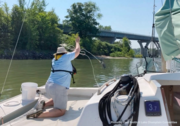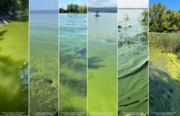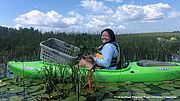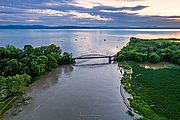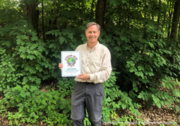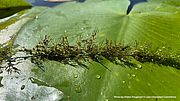On Monday April 8, 2024 the skies above Lake Champlain will go dark in the middle of the afternoon. Almost all of the lake is in the path of totality for the solar eclipse of 2024 passing through Mexico, the US, and Canada. It’s a historic occurrence—on average, any given location sees a total solar eclipse every 355 years. The LCC team is excited to experience this rare celestial event and will be heading out on foot to various viewing locations in the Lake Champlain watershed. Read on for information and resources about what a solar eclipse is, where to go, where not to go, Leave No Trace principles, a solar eclipse sundial, safety, community science opportunities, regional guides, and more to help you experience this once-in-a-lifetime phenomena. Read...
News from Selected Month
With no concept of weeks, months, or daylight savings—frogs and salamanders rely entirely on environmental cues of temperature and precipitation to tell them when it’s time to start their vernal lifestyle. What does this seasonal shift look like, and how have humans affected it? Read...
Read on to see what LCC and Lake Champlain have been up to lately! Read...
Stormwater runoff poses a major challenge for water quality in Lake Champlain. When rain falls on impervious surfaces, it does not have the chance to infiltrate into the ground and instead flows over roofs, parking lots, and roads—collecting pollutants and nutrients along the way—until it eventually reaches the lake, untreated. Runoff from developed land contributes more phosphorus to Lake Champlain than any other land use type per area. Read...
For about as long as we have had agriculture, we have had agricultural pests—insects and other creatures who make their living off food we grow. We’ve been in an evolutionary showdown with these pests for centuries, adapting new technologies to better protect our food. The stakes of the back and forth increased dramatically with the advent of chemical pesticides. In the 1980’s, a specific class of pesticide was developed called neonicotinoids, or “neonics”. Read...
The changing of the seasons in the Lake Champlain Basin brings new wonders to the avian world. Cartoonist, writer, avid birder, and graduate of the University of Vermont’s Field Naturalist Program Rosemary Mosco broke down the four seasons of bird watching in the Northeast US: Elegant Songbird Spring, Subtle Treasures of Summer, Magnificent Fall Migrations, and the season we are now in—Weird Duck Time. Read...
While the winter of 2024 has been unseasonably warm, we still needed to turn on the heat and don extra layers to adjust to the seasonal change. But what about the lake’s vegetative life? How have the native aquatic plants of Lake Champlain evolved to survive winter? Read...
American bullfrogs (Lithobates catesbeianus) are deeply associated with spring and summer–their deep “jug-o-rum” serenade evokes images of hot summer nights: fireflies, and leafed-out trees. But what are they up to during cooler times? As with all living things in the Lake Champlain region, bullfrogs need to adapt to the winter season, and as aquatic amphibians, many do this in the lake itself. Read...
Sincere thanks to our wonderful team of cyanobacteria monitors and partner organizations for diligently checking Lake Champlain and inland lake locations during the 2023 season. Monitors collectively filed nearly 3,000 reports over a 19-week period. Read...
We don’t often give surface water much thought on its journey after it enters a storm drain–out of sight, out of mind. But the health of the waters going through storm drains is intrinsically tied to the health of all of our waters. It’s a common misconception that storm drains usually lead to wastewater treatment plants. In reality, most of this water is directly discharged into nearby waterbodies, and in the Lake Champlain basin, that means it eventually winds up in the lake. Read...
LCC Action Alert - ask your state rep. to support H.706 to protect ecosystems from neonic pesticides
LCC is working with a coalition of partners in support of Vermont legislation to protect pollinators and water ecosystems by dramatically curtailing the use of “neonics”. H.706 would phase out up to 90% of neonics over the course of the next five years, with certain emergency exemptions for farmers. Help get this bill passed by contacting your state reps today and asking them to support H.706. Read...
Dozens of beekeepers, students, conservationists, environmental advocates, and pollinator enthusiasts of all sorts gathered at the Vermont State House today to make the case for providing greater protections for pollinators and aquatic ecosystems. “Not only do neonic pesticides lead to die offs of honeybees, wild pollinators, and birds, they also leach into groundwater and wash into surface waters with precipitation,” stated Lori Fisher, Executive Director of LCC. “This degrades water quality and harms aquatic insects, particularly mayflies and damselflies. These and other invertebrates are vital species that are a cornerstone of a healthy aquatic ecosystem.” Read...
March 2024 - Neonicotinoids, or "neonics" are versatile chemical pesticides that can be treated on a plant’s seeds so they’re built into the plant as it grows. As research continues to emerge on the harms that this class of chemicals has to the ecosystem beyond their targets, we need to seriously reconsider this practice and stop using these pesticides. Read...
What effect did the floods of Summer and again in December in 2023 have on fish? We talked with Will Eldridge from Vermont Fish and Wildlife to see what these floods did for fish from the headwaters to the lake. Read...
The four seasons of bird watching in the Northeast US: Elegant Songbird Spring, Subtle Treasures of Summer, Magnificent Fall Migrations, and the season we are now in—Weird Duck Time. Read...
The time of year for winterization is upon us: we seal windows, run heaters, open boxes of coats and mittens, and dust off sleds and skis. These are all strategies that humans in colder climes like the Lake Champlain basin employ for winter survival and enjoyment. But what about the lake’s vegetative life? How have the native aquatic plants of Lake Champlain evolved to survive winter? Read...
The Lake Champlain Committee (LCC) and the Vermont Citizens’ Advisory Committee (VT CAC) invite you to the Lake Champlain Community Sailing Center on Monday, 11/13/23 at 5:00 PM to learn more about lake issues and how Lake Champlain was affected by summer floods. Click to learn more! Read...
From afar, a patch of bright green on any body of water is cause for alarm: we are too used to the sight of cyanobacteria plaguing shallow waters close to shore. But get closer to determine what you’re seeing. It may be neither cyanobacteria nor algae, but tiny, individual plants known as duckweed. Read...
In this email you’ll find details of Week 18 monitoring along with information to help you recognize and report on cyanobacteria. Click on the links for scenes of fall blooms on Lake Champlain’s Inland Sea and Missisquoi Bay; a low alert bloom at Burlington’s Coast Guard boat access on Lake Champlain’s Main Lake Central; pictures of the varied conditions witnessed during Week 18 from clear water to high alert blooms; photos of Prouty Bay Lake Memphremagog post-bloom; shots of a high alert at Philipsburg Public Park QC on Lake Champlain’s Missisquoi Bay; pristine scenes at Blanchard Beach and Texaco Beach in Burlington VT on Lake Champlain’s Main Lake Central; autumn observations at St. Anne’s Shrine in Isle La Motte VT, and Burlington VT sites at Blanchard Beach, Oakledge Rocky Shore, and North Beach; and a snapshot of Missisquoi Bay monitor Nancy Lambert in action at her QC site. You can also learn about iron bacteria (and how to distinguish it from a petroleum sheen) and duckweed—which is often confused with cyanobacteria from a distance. If you’re intrigued about duckweed, you’ll find more information about the smallest known flowering plant in the world in LCC’s Lake Look column on our website. Read...
Brrr! It’s getting chilly in and around our waterways as fall fully takes hold. However, cyanobacteria blooms are still happening at various Lake Champlain and inland lake locations. Please use the resources in this email to learn how to recognize, avoid, and report cyanobacteria. Read on for details of Week 17 monitoring results along with resources to guide your reporting. Click on the links for a picture of LCC monitor Alfred Cumming taking a cold water sample, scenes of low alert blooms at Lake Memphremagog’s Derby Bay and Newport Marina and at Lake Champlain sites on Missisquoi Bay and the Inland Sea, and pictures of Lake Champlain clear water at St. Anne’s Shrine, Stoney Point, and DAR State Park.
While reports continue to dwindle as more monitors leave shoreline areas, we continue to see blooms. Please use the resources in this email to learn how to recognize, avoid, and report cyanobacteria. Click on the links for how to join our monitoring team in 2024 and to see pictures clear water conditions at Philipsburg QC and Burlington VT, an autumn alert at Hills Point Charlotte VT, fall leaves amongst cyanobacteria, and blooms at Graveyard Point North Hero VT on Lake Champlain and Prouty Bay on Lake Memphremagog. Read...
Fall is a time of year when we have far fewer monitors reporting but blooms can still occur. This email includes details of Week 15 monitoring results along with resources to help you recognize cyanobacteria and stay informed about water quality. You’ll also find photos of iron bacteria, bloom close-ups from Lake Champlain and Lake Memphremagog, and cyanobacteria sightings at Philipsburg QC, Isle La Motte VT, Alburgh VT, North Hero VT, South Burlington VT, Peacham Pond, and Lake Memphremagog. Read...
Fall is a time of year when we have far fewer monitors reporting but blooms are still prevalent. Forty-three percent of the Lake Champlain reports and 8 percent of the VT inland lake reports we received for Week 14 were of blooms. Please use the resources and photos in this email to help you learn how to recognize cyanobacteria and stay informed about water quality. Read...
Week 13 was a challenging one as blooms took off in new areas and persisted in others and the online reporting system overseen by the VT Dept. of Health (VDH) was not accessible for several days while IT staff worked to resolve issues. This meant monitors had to try to submit reports multiple times and LCC staff had a backlog of reports to sort through and vet once the tracker came back online. Over one third of the 126 reports we ultimately received during the week were of blooms which further reinforces the need to check water conditions carefully even during the fall.
Lake Champlain currently has 51 known aquatic non-native and invasive species of plants, fish, mussels, and other freshwater dwellers. Invasive species are both non-native, or introduced to an area outside the range in which they evolved, and nuisance, or disruptors of the ecosystem into which they were introduced. Zebra mussels, Eurasian watermilfoil, and water chestnut are all invasive species found in Lake Champlain.
Humans have the greatest influence on the spread of invasives—hitchhikers need a ride to get to where they’re going, and humans are highly-mobile hosts that give rides knowingly through deliberately releasing fish into waterways or flushing exotic aquarium plants down the toilet, and unknowingly on watercraft. Fortunately, humans can also play a key role in early detection and spread prevention. That is why the Lake Champlain Committee (LCC) started a new community science project: the Champlain Aquatic invasive Monitoring Program (CHAMP!) with funding from the Lake Champlain Basin Program. Read...
Hints of color are starting to show in the Adirondacks and the Green Mountains as we move into fall. Another dramatic show of color that elicits less awe and more concern has been in the lake between these mountains since early summer—the blues and greens of cyanobacteria blooms.
“Witnessing a cyanobacteria bloom can take an emotional toll,” notes LCC Executive Director Lori Fisher. “Blooms threaten water quality, public health, recreation, the economy, and quality of life. Monitoring is a way for people to get actively involved in lake protection by gathering and sharing data. And that monitoring is not the end result – it’s foundational to LCC’s nutrient reduction advocacy.” Read...
Gardens were not the only places being weeded in August—LCC hosted a water chestnut removal event with the Vermont Department of Environmental Conservation at the Sandbar Wildlife Management Area in Colchester, VT. Volunteers spent the morning paddling the shallow waters north of the mouth of the Lamoille River and pulling up the invasive plant to help prevent it from colonizing the area. Read...
The Summer 2023 floods brought devastation to so many throughout the Lake Champlain Basin—they inundated homes and businesses, destroyed crops and livelihoods, and washed away roads. On paper, it will be a costly recovery, but the true cost of the destruction cannot be measured in money alone. Rivers throughout the basin rushed to levels not seen in nearly 100 years, with staggeringly high flow ultimately pouring into Lake Champlain. What did the rivers carry, what does this mean for the lake, and how can we be more resilient in the future? Read...
The Lake Champlain Committee is a partner in a new program called Stream Wise. Organized by the Lake Champlain Basin Program, Stream Wise is a way for people who live near streams and rivers to be recognized and rewarded for maintaining a healthy stream buffer. The program consists of an assessment where a trained Stream Wise assessor visits your property and helps determine if it meets the criteria to be considered “Stream Wise” and issues awards and recommendations accordingly. It helps landowners learn about what makes a stream buffer effective and how to improve the land around the waterway that runs through or along their property. Read...
In the shallow shores of Lake Champlain, a predator who engulfs its prey in milliseconds floats just below the surface, waiting for the next unlucky victim. It is neither freshwater shark nor sinister cryptid cousin to Champ, but actually a seemingly innocuous, yet carnivorous native plant: the bladderwort. Read...
